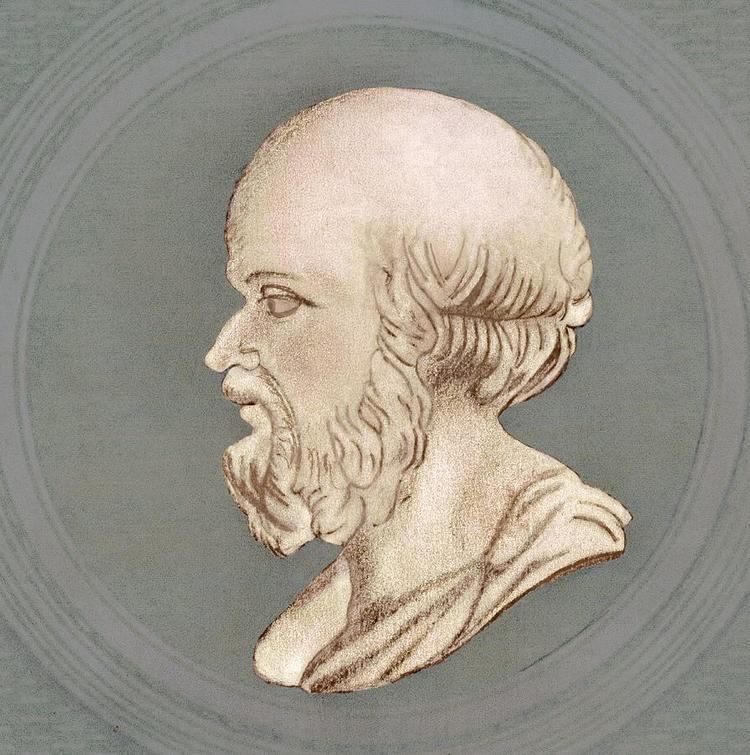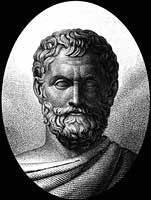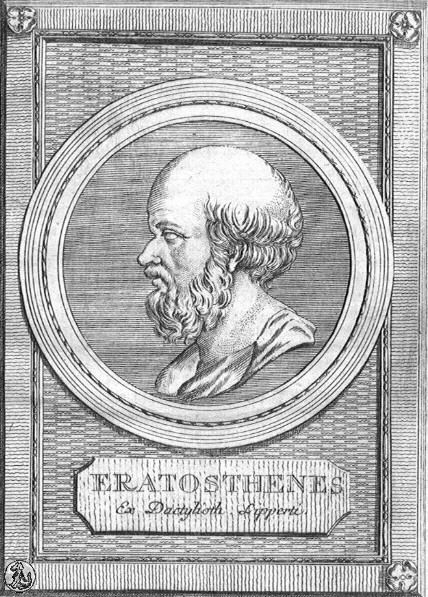Parents Aglaus | Name Eratosthenes Eratosthenes Died 194 BC, Alexandria, Egypt | |
 | ||
Occupation ScholarLibrarianPoetInventor Similar Aristarchus of Samos, Hipparchus, Ptolemy Died 194 BC (around age 82) Alexandria | ||
Eratosthenes
Eratosthenes of Cyrene (; Greek: Ἐρατοσθένης ὁ Κυρηναῖος, [eratostʰénɛːs]; c. 276 BC – c. 195/194 BC) was a Greek mathematician, geographer, poet, astronomer, and music theorist. He was a man of learning, becoming the chief librarian at the Library of Alexandria. He invented the discipline of geography, including the terminology used today.
Contents
- Eratosthenes
- Life
- Measurement of the Earths circumference
- Father of geography
- Achievements
- Prime numbers
- Works
- Titles
- References

He is best known for being the first person to calculate the circumference of the Earth, which he did by applying a measuring system using stadia, a standard unit of measure during that time period. His calculation was remarkably accurate. He was also the first to calculate the tilt of the Earth's axis (again with remarkable accuracy). Additionally, he may have accurately calculated the distance from the Earth to the Sun and invented the leap day. He created the first map of the world, incorporating parallels and meridians based on the available geographic knowledge of his era.

Eratosthenes was the founder of scientific chronology; he endeavored to revise the dates of the chief literary and political events from the conquest of Troy. Eratosthenes dated The Sack of Troy to 1183 BC. In number theory, he introduced the sieve of Eratosthenes, an efficient method of identifying prime numbers.

He was a figure of influence in many fields. According to an entry in the Suda (a 10th-century reference), his critics scorned him, calling him Beta (the second letter of the Greek alphabet) because he always came in second in all his endeavors. Nonetheless, his devotees nicknamed him Pentathlos after the Olympians who were well rounded competitors, for he had proven himself to be knowledgeable in every area of learning. Eratosthenes yearned to understand the complexities of the entire world.

Eratosthenes
Life
The son of Aglaos, Eratosthenes was born in 276 BC in Cyrene. Now part of modern-day Libya, Cyrene had been founded by the Greeks centuries earlier and became the capital of Pentapolis (North Africa), a country of five cities: Cyrene, Arsinoe, Berenice, Ptolemias, and Apollonia, Cyrenaica. Alexander the Great conquered Cyrene in 332 BC, and following his death in 323 BC, its rule was given to one of his generals, Ptolemy I Soter, the founder of the Ptolemaic Kingdom. Under Ptolemaic rule the economy prospered, based largely on the export of horses and silphium, a plant used for rich seasoning and medicine. Cyrene became a place of cultivation, where knowledge blossomed. Like any young Greek, Eratosthenes would have studied in the local gymnasium, where he would have learned physical skills and social discourse as well as reading, writing, arithmetic, poetry, and music.
Eratosthenes went to Athens to further his studies. There he was taught Stoicism by its founder, Zeno of Citium, in philosophical lectures on living a virtuous life. He then studied under Ariston of Chios, who led a more cynical school of philosophy. He also studied under the head of the Platonic Academy, who was Arcesilaus of Pitane. His interest in Plato led him to write his very first work at a scholarly level, Platonikos, inquiring into the mathematical foundation of Plato's philosophies. Eratosthenes was a man of many perspectives and investigated the art of poetry under Callimachus. He was a talented and imaginative poet. He wrote poems: one in hexameters called Hermes, illustrating the god's life history; and another, in elegiacs called Erigone, describing the suicide of the Athenian maiden Erigone (daughter of Icarius). He wrote Chronographies, a text that scientifically depicted dates of importance, beginning with the Trojan War. This work was highly esteemed for its accuracy. George Syncellus was later able to preserve from Chronographies a list of 38 kings of the Egyptian Thebes. Eratosthenes also wrote Olympic Victors, a chronology of the winners of the Olympic Games. It is not known when he wrote his works, but they highlighted his abilities.
These works and his great poetic abilities led the pharaoh Ptolemy III Euergetes to seek to place him as a librarian at the Library of Alexandria in the year 245 BC. Eratosthenes, then thirty years old, accepted Ptolemy's invitation and traveled to Alexandria, where he lived for the rest of his life. Within about five years he became Chief Librarian, a position that the poet Apollonius Rhodius had previously held. As head of the library Eratosthenes tutored the children of Ptolemy, including Ptolemy IV Philopator who became the fourth Ptolemaic pharaoh. He expanded the library's holdings: in Alexandria all books had to be surrendered for duplication. It was said that these were copied so accurately that it was impossible to tell if the library had returned the original or the copy. He sought to maintain the reputation of the Library of Alexandria against competition from the Library of Pergamum. Eratosthenes created a whole section devoted to the examination of Homer, and acquired original works of great tragic dramas of Aeschylus, Sophocles and Euripides.
Eratosthenes made several important contributions to mathematics and science, and was a friend of Archimedes. Around 255 BC, he invented the armillary sphere. In On the Circular Motions of the Celestial Bodies, Cleomedes credited him with having calculated the Earth's circumference around 240 BC, using knowledge of the angle of elevation of the Sun at noon on the summer solstice in Alexandria and on Elephantine Island near Syene (modern Aswan, Egypt).
Eratosthenes believed there was good and bad in every nation and criticized Aristotle for arguing that humanity was divided into Greeks and barbarians, and that the Greeks should keep themselves racially pure. As he aged he contracted ophthalmia, becoming blind around 195 BC. Losing the ability to read and to observe nature plagued and depressed him, leading him to voluntarily starve himself to death. He died in 194 BC at 82 in Alexandria.
Measurement of the Earth's circumference
Eratosthenes calculated the circumference of the Earth without leaving Egypt. He knew that at local noon on the summer solstice in Syene (modern Aswan, Egypt), the Sun was directly overhead. (Syene is at latitude 24°05′ North, near to the Tropic of Cancer, which was 23°42′ North in 100 BC) He knew this because the shadow of someone looking down a deep well at that time in Syene blocked the reflection of the Sun on the water. He measured the Sun's angle of elevation at noon on the same day in Alexandria. The method of measurement was to make a scale drawing of that right triangle with the vertical rod and its shadow as its legs and to measure the acute angle subtending to the shadow. This turned out to be about 7°, or 1/50th of the way around a circle. Taking the Earth as spherical, and knowing both the distance and direction of Syene, he concluded that the Earth's circumference was fifty times that distance.
His knowledge of the size of Egypt was founded on the work of many generations of surveying trips. Pharaonic bookkeepers gave a distance between Syene and Alexandria of 5,000 stadia (a figure that was checked yearly). Some say that the distance was corroborated by inquiring about the time that it took to travel from Syene to Alexandria by camel. Carl Sagan said that Eratosthenes paid a man to walk and measure the distance. Some claim Eratosthenes used the Olympic stade of 176.4 m, which would imply a circumference of 44,100 km, an error of 10%, but the 184.8 m Italian stade became (300 years later) the most commonly accepted value for the length of the stade, which implies a circumference of 46,100 km, an error of 15%. It was unlikely, even accounting for his extremely primitive measuring tools, that Eratosthenes could have calculated an accurate measurement for the circumference of the Earth. He made five important assumptions (none of which is perfectly accurate):
- That the distance between Alexandria and Syene was 5000 stadia,
- That Alexandria is due north of Syene
- That Syene lies on the Tropic of Cancer
- That the Earth is a perfect sphere.
- That light rays emanating from the Sun are parallel.
Eratosthenes later rounded the result to a final value of 700 stadia per degree, which implies a circumference of 252,000 stadia, likely for reasons of calculation simplicity as the larger number is evenly divisible by 60. In 2012, Anthony Abreu Mora repeated Eratosthenes's calculation with more accurate data; the result was 40,074 km, which is 66 km different (0.16%) from the currently accepted polar circumference of the Earth.
Seventeen hundred years after Eratosthenes's death, while Christopher Columbus studied what Eratosthenes had written about the size of the Earth, he chose to believe, based on a map by Toscanelli, that the Earth's circumference was one-third smaller. Had Columbus set sail knowing that Eratosthenes's larger circumference value was more accurate, he would have known that the place that he made landfall was not Asia, but rather the New World.
"Father of geography"
Eratosthenes now continued from his knowledge about the Earth. Using his discoveries and knowledge of its size and shape, he began to sketch it. In the Library of Alexandria he had access to various travel books, which contained various items of information and representations of the world that needed to be pieced together in some organized format. In his three-volume work Geography (Greek: Geographika), he described and mapped his entire known world, even dividing the Earth into five climate zones: two freezing zones around the poles, two temperate zones, and a zone encompassing the equator and the tropics. He had invented geography. He created terminology that is still used today. He placed grids of overlapping lines over the surface of the Earth. He used parallels and meridians to link together every place in the world. It was now possible to estimate one's distance from remote locations with this network over the surface of the Earth. In the Geography the names of over 400 cities and their locations were shown: this had never been achieved before. Unfortunately, his Geography has been lost to history, but fragments of the work can be pieced together from other great historians like Pliny, Polybius, Strabo, and Marcianus.
Achievements
Eratosthenes was described by the Suda Lexicon as a Πένταθλος (Pentathlos) which can be translated as "All-Rounder", for he was skilled in a variety of things: He was a true polymath. He was nicknamed Beta because he was great at many things and tried to get his hands on every bit of information but never achieved the highest rank in anything; Strabo accounts Eratosthenes as a mathematician among geographers and a geographer among mathematicians.
Prime numbers
Eratosthenes proposed a simple algorithm for finding prime numbers. This algorithm is known in mathematics as the Sieve of Eratosthenes.
In mathematics, the sieve of Eratosthenes (Greek: κόσκινον Ἐρατοσθένους), one of a number of prime number sieves, is a simple, ancient algorithm for finding all prime numbers up to any given limit. It does so by iteratively marking as composite, i.e., not prime, the multiples of each prime, starting with the multiples of 2. The multiples of a given prime are generated starting from that prime, as a sequence of numbers with the same difference, equal to that prime, between consecutive numbers. This is the sieve's key distinction from using trial division to sequentially test each candidate number for divisibility by each prime.
Works
Eratosthenes was one of the most pre-eminent scholarly figures of his time, and produced works covering a vast area of knowledge before and during his time at the Library. He wrote on many topics — geography, mathematics, philosophy, chronology, literary criticism, grammar, poetry, and even old comedies. Unfortunately, there are only fragments left of his works after the Destruction of the Library of Alexandria.
